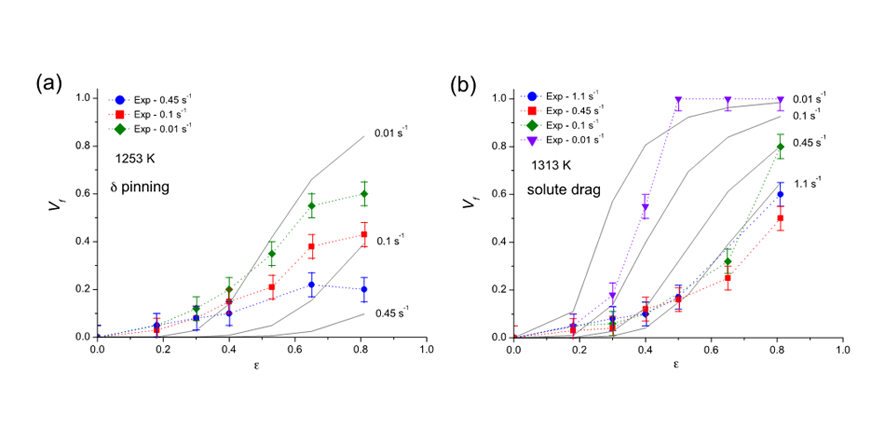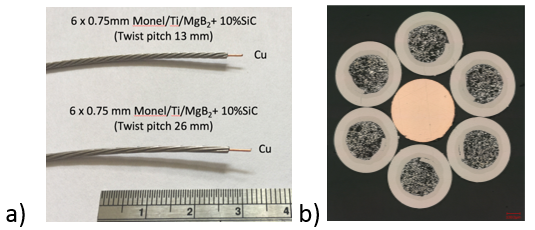
Banner image: An example of process modelling applied to a Nickel-based superalloy, where a new model has been developed to predict dynamic recrystallisation including effects of composition and initial microstructure. Predicted and validated recrystallization fraction when (a) particle pinning and (b) solute drag operate (www.sciencedirect.com/science/article/pii/S0921509315003810)
Every man-made item has been manufactured, the most obvious sign of which is shape. However, obtaining the desired form is not the only function of these processes, as they also have a significant effect on the properties of a material. Therefore, understanding process-property relationships, material formability and incorporating this knowledge into process models is critically important to developing the optimised and efficient manufacturing routes demanded by modern industry. Research within the department spans from conventional thermomechanical processes, such as casting and forging, to the very latest technologies, for example additive layer manufacturing, working with a wide range of industrial and academic partners to understand, improve and develop their processes to deliver enhanced final products.
Microstructural evolution during thermomechanical processing
Thermomechanical processing is an essential part of many industrial manufacturing routes, as these operations remove casting defects and refine the microstructure of the material. Within the Department, work is being undertaken to understand the evolution of different materials during these operations, the influence of process parameters and enhance our understanding of phenomena such as dynamic recrystallisation, dynamic recovery and the development of crystallographic texture.
Additive layer manufacturing
Additive layer manufacturing offers the prospect of producing engineering components with fundamentally new architectures, potentially giving dramatic improvements in efficiency. However, the production of full components from high performance alloys via this technology is still in its infancy and there are many technical challenges that need to be addressed, such as managing the large thermal gradients and stresses, as well as achieving suitable mechanical properties. Research within the Department is investigating the influence of different build parameters on the microstructure and properties of a number of different advanced alloys to identify the optimal processing windows. In addition, new, bespoke alloys are being designed specifically for this manufacturing route to try and overcome some of the difficulties that have been observed with existing materials.
Process modelling
Multiple mechanisms operate during the thermomechanical processing of advanced materials, including recrystallisation, grain growth, dislocation recovery and precipitation. Work within the Department is developing and utilising novel simulation techniques across various length/time- scales to describe the relevant processes involved in microstructure evolution. The figure below shows an example applied to a Nickel-based superalloy, where a new model has been developed to predict dynamic recrystallisation including effects of composition and initial microstructure.
Powder-In-Tube technology
Manufacturing of composite superconductors for energy applications using Powder-In-Tube technology, requires understanding of deformation processes of multicomponent powders of different mechanical and electric properties via metallic external cover. We have engineered a state-of-the-art production line that enables the production of MgB2 superconducting wires with excellent physical properties suitable for various applications at a fraction of the cost and at production speeds that can meet the future demand. A novel manufacturing technology to produce infinitely long and cost effective composite single core MgB2 superconductive wires has been developed. The continuous process comprises unique powder feeding technology allowing micron sized Mg and nano-sized B as well as SiC dopant powders to be fed continuously to a ‘U’ shaped metallic sheath material (e.g. titanium, monel). Laser seam welding technology has been applied to seal the conductor seam allowing continuous wire production. Deformation characteristics of wires produced by single and bimetallic sheath materials have been studied. Our main targets are the MRI market, power generation, power storage and power distribution applications.

Figure caption: a) Photograph of a “6+1” configuration cable constructed from six 0.75 mm Monel/Titanium/(MgB2+10 wt%SiC) wires and one central copper wire showing twist pitch 13 mm and 26 mm; b) cross section of the “6+1” unreacted Monel/Titanium/(MgB2+10 wt%SiC)/Cu conductor.
Ink jet printing of superconducting coatings
A successful application of ink-jet printing to the deposition of both continuous coatings and multi-filamentary structures of YBCO has been implemented in a production line at BASF. Stable inks have been prepared using both the established TFA-MOD route and novel fluorine-free precursors with appropriate rheological properties for ink-jet printing. Continuous and well textured coatings with lengths exceeding 100 m and a thickness of 0.5 mm have been deposited by electromagnetic ink-jet printing from TFA precursors on LZO-buffered Ni–W substrates and samples have achieved a Jc ~ 1.5 MA/cm2 (self-field, 77 K).

Figure caption: a) Photograph of a “6+1” configuration cable constructed from six 0.75 mm Monel/Titanium/(MgB2+10 wt%SiC) wires and one central copper wire showing twist pitch 13 mm and 26 mm; b) cross section of the “6+1” unreacted Monel/Titanium/(MgB2+10 wt%SiC)/Cu conductor.
